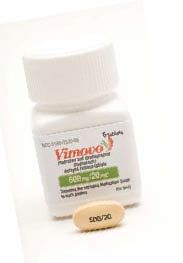Publication
Article
Pharmacy Times
Rx Product Profile: AstraZeneca and Pozen Inc's Vimovo
Vimovo (naproxen and esomeprazole magnesium) delayed-released tablets, marketed by AstraZeneca and Pozen Inc, are FDA approved for the symptomatic relief of arthritic conditions.
Vimovo (naproxen and esomeprazole magnesium) delayed-released tablets, marketed by AstraZeneca and Pozen Inc, are FDA approved for the symptomatic relief of arthritic conditions.

ASTRAZENECA AND POZEN INC’S VIMOVO
On April 30, 2010, the FDA approved AstraZeneca and POZEN Inc’s Vimovo (naproxen and esomeprazole magnesium) delayed-release tablets for the symptomatic relief of osteoarthritis, rheumatoid arthritis, and ankylosing spondylitis in patients at risk for developing nonsteroidal anti-inflammatory drug (NSAID)- related ulcers.1 Vimovo is formulated in a single tablet from the NSAID naproxen in an enteric coating and the proton pump inhibitor (PPI) esomeprazole magnesium trihydrate.2 Many patients treat arthritis with NSAIDs, and 50% of those who use NSAIDs regularly are at risk of developing gastrointestinal ulcers.1 PPIs are efficacious in reducing NSAID-associated gastrointestinal toxicity.3 Naproxen and esomeprazole are available separately. Inadequate dosing and adherence is an issue when prescribed separately, however, and this results in suboptimal control of gastric toxicity.3 An option of a combination tablet on the market may help with adherence.
Clinical Trials
The approval of Vimovo by the FDA was based on 2 clinical trials. Two phase-3 double- blind, parallel-group studies enrolled men and women randomized to receive Vimovo 500/20 mg or enteric-coated (EC) naproxen 500 mg taken twice a day before a meal. Subjects were further stratified by use of low-dose aspirin, defined as ≤325 mg.3,4 Inclusion criteria were Helicobacter pylori—negative and osteoarthritis, rheumatoid arthritis, ankylosing spondylitis, or any other condition requiring 6-month NSAID therapy as diagnosed by their clinician. Both studies randomized a total of 861 subjects aged 50 years or older or aged 18 to 49 years. Both studies had a higher enrollment of women in all groups (approximately 69%) and both studies had a higher percentage of subjects with osteoarthritis (78%-82%).
The primary endpoint was cumulative incidence of endoscopy gastric ulcers observed at months 1, 3, and 6. In both studies, the Vimovo treatment arm had a lower incidence of gastric ulcers than the comparator naproxen (6.4% vs 22.2%, respectively).3,4 The low-dose aspirin users generated similar results: Vimovo = 3% and EC naproxen = 28.4%. The cumulative incidence of duodenal ulcers was also lower in the Vimovo arm for both studies.3,4
The most common adverse reactions in clinical trials were erosive gastritis, dyspepsia, gastritis, diarrhea, gastric ulcers, upper abdominal pain, and nausea.2
Pharmacokinetics
Vimovo is a multilayer tablet with an inner core of naproxen sodium surrounded with esomeprazole. Esomeprazole is immediately released first in the stomach and, due to the enteric coating, the naproxen is then released in the small intestine above a pH of 5.5. Naproxen and esomeprazole are extensively metabolized by the liver.2 Naproxen is primarily excreted by the kidney.2 The pharmacokinetics of Vimovo in hepatic or renal insufficiency has not been studied. Naproxen and naproxencontaining drugs are not recommended in patients with moderate to severe renal insufficiency.2 Dosage and Administration
Vimovo is available in 375 or 500 mg of naproxen combined with 20 mg of esomeprazole magnesium. The dosing of Vimovo is 1 tablet twice daily.2 The tablets are to be swallowed whole (not crushed, split, or chewed) with liquid and should be taken at least 30 minutes before meals.2
Vimovo carries a warning of cardiovascular and gastrointestinal risks. Cardiovascular events include thrombotic events, myocardial infarction, and stroke; gastrointestinal events include bleeding ulceration and perforation of stomach or intestines. Vimovo is contraindicated for perioperative pain associated with coronary bypass graft surgery, pregnancy, and aspirin or NSAID allergy.
Both Ms. Belisle and Dr. Patel are pharmacists at Brigham and Women’s Hospital, Boston, Massachusetts. Brendan Whooley is a third-year PharmD candidate from Northeastern University School of Pharmacy currently on clinical cooperative rotation in the Investigational Drug Service at Brigham and Women’s Hospital, Boston, Massachusetts.
References
- FDA approved VIMOVO for arthritis patients at risk of developing NSAID-associated gastric ulcers [press release.] Available at: www.astrazeneca-us.com/about-astrazeneca-us/newsroom/all/8889795?itemId=8889795
- Vimovo.[package inert]. Wilmington, DE: AstraZeneca 2010.
- Goldstein JL, Hochberg MC, Fort JG, et al. Clinical trial: the incidence of NSAID-associated endoscopic gastric ulcers in patients treated with PN 400 (naproxen plus esomeprazole magnesium) vs. enteric-coated naproxen alone. Aliment Pharmacol Ther. 2010;32:401-413
- Dear Healthcare Professional Letter: AstraZeneca August 13, 2010.







